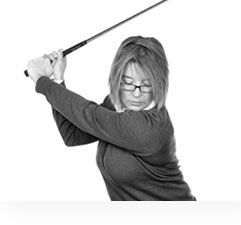 Natalie Adams – PGA Teaching Pro
Natalie Adams – PGA Teaching Pro
Many golfers will ask me, what’s the correct amount of hit turn to have during a good consistent golf swing. The answer to that really does depend on flexibility. But ideally, we’re looking to turn your shoulders to 90 degrees right, on your back swing if you are a right handed golfer, but your hips are going to turn to 45 degrees. So we don’t want too much excessive hit turn. Excessive hit turn can cause you to overswing. So if you’re turning your hips to much, you can end up collapsing and over swinging, but certainly not enough hit turns. So being too quite and too static with the hips wont allow you to turn your shoulders enough, so you wont generate as much back swing and you can’t get as much speed into the club on thedown swing. So, the correct amount to turn is 45 degrees on the hips, good way to practice this; if you put two clubs, one across your hips and one across your shoulders, we want to look here, that your shoulders, as they start to turn, the hips stay really still. So we’re going to turn until your shoulders starts to feel some resistance.
That will be around 45 degrees to the right in a right handed player. Once you get to this position, you’re then just going to gently allow the hips to turn to allow the shoulders to get to 90 degrees. So you can see there’s more turningthe shoulders than there is in the hips. This is creating a more 90 degrees shoulder turn, but a 45 degree hit turn. So, good way to workon that when you are on the range, would be to focus on your belt buckle. As you start and you’re in your set up position, your belt buckle’s pointing at the ball, as you swing back for the first two to three feet of the swing, keep the belt buckle pointing at the ball.
Once you get in this position, you start to feel the resistance in your shoulders, you can allow your belt buckle just to rotate to the right, so it feels now like it's pointing just past your right foot. As you swing back in, we want to let the hips turn back in, so we’re going to work turning the belt buckle toward the target and finishing with the belt buckle pointing at the target or slightly left of it. If you work on that on the range and then take it onto the course, that should help you become a lot more consistent and create a lot more length for you.





